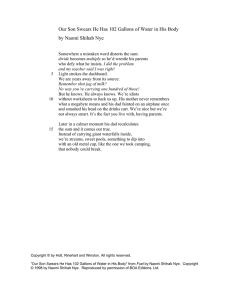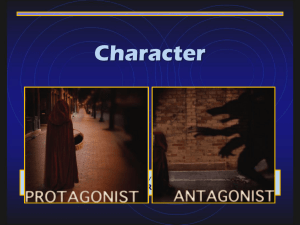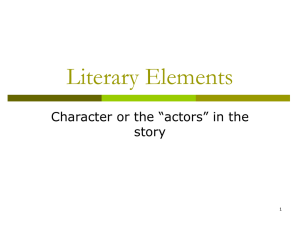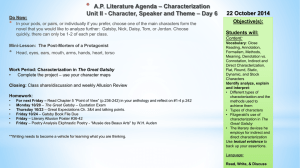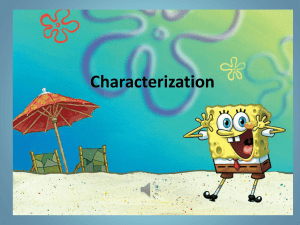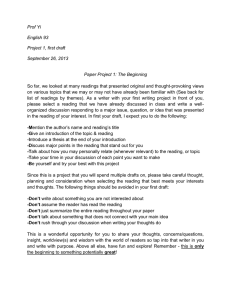9/11 – The Rising - Ms. Sheridan
advertisement
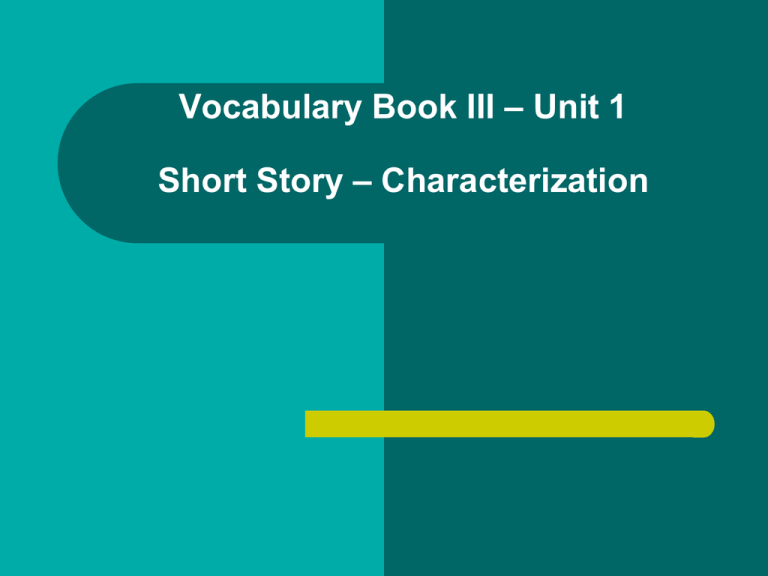
Vocabulary Book III – Unit 1 Short Story – Characterization Take Out Binder with Paper Remember to use Cornell Note-taking method. Topic: Literary Terms Write down the words and definitions in your notebooks. Lit. Term in column on left and definition in column on right. Objectives - Characterization 1. 2. 3. You will be able to: Read for comprehension. Analyze a story to determine the method of characterization. Analyze story for meaning. Characterization http://player.discoveryeducation.com/index.cfm? guidAssetId=DB78C7F0-5E84-4B35-9511E13F8435A536&blnFromSearch=1&productcod e=US Characters the people or animals who take part in the action of a literary work Static & Dynamic Characters Static - A static character does not change throughout the work, and the reader’s knowledge of that character does not grow, Dynamic - A dynamic character undergoes some kind of change because of the action in the plot. Static & Dynamic Characters Static - A static character does not change throughout the work, and the reader’s knowledge of that character does not grow, Static & Dynamic Characters Dynamic - A dynamic character undergoes some kind of change because of the action in the plot. Round & Flat Characters Round - A round character has many character traits or qualities. They have many likes, dislikes, opinions, beliefs and attitudes. Flat - A flat character has only one or two personality traits. A ‘type” without unique opinions, beliefs or attitudes. characterization the ways in which a writer develops a character, making him or her seem believable characterization Two Methods of Characterization – – 1 - Direct Characterization - The writer tells you the characters’ traits through the narrator's direct statements and descriptions 2 - Indirect Characterization - The writer reveals the characters' personalities through their own words, thoughts, and actions, as well as by what other characters say to them or about them. Indirect Characterization – Most Often Used – Why? More often, writers will have us listen to what their characters say and watch what they do. Then we can draw our own conclusions about the kind of people we are meeting. Writers can reveal a character’s personality in five ways: 1. By letting us hear the character speak; 2. by describing how the character looks and dresses; 3. by letting us listen to the character's inner thoughts and feelings; 4. by revealing what other people in the story think or say about the character; and 5. by showing us what the character does-how he or she acts. Example Although she was a stranger to him, Bobby looked at her hand-me-down outfit with disdain and asked, “Is that the best clothes you have?” Describe Bobby: Read Literature Text Pages Page 532-533 Characterization Reading Strategy – Identifying with a Character Write down textbook vocab. in notes Isaac Singer – “The Day I Got Lost” – Meet the Author – Isaac Bashevis Singer (November 21, 1902 – July 24, 1991) was a Polish-born Jewish American author noted for his short stories. He was one of the leading figures in the Yiddish literary movement, and received the Nobel Prize in literature in 1978. – See page 538 Naomi Shihab Nye – “Hamadi” – – – – – Meet the Author Naomi Shihab Nye (1952 - Present) Naomi Shihab Nye is a poet and songwriter born in 1952 to a Palestinian father and American mother. She grew up in St. Louis, Missouri, Jerusalem, and San Antonio, Texas. Both roots and sense of place are major themes in her body of work. Her first collection of poems, Different Ways to Pray, explored the theme of similarities and differences between cultures, which would become one of her lifelong areas of focus. See page 546 Isaac Singer – “The Day I Got Lost” – – – Have you ever met someone brilliant who can never find his/her keys? Have you ever heard the term “absent-minded professor?” Page 535 Naomi Shihab Nye – “Hamadi” – Background – Author/Philosopher Kahlil Gibran is referenced. – Hate is a dead thing. Who of you would be a tomb? - Sand and Foam Perplexity is the beginning of knowledge. - The Voice of the Master A little knowledge that acts is worth infinitely more than much knowledge that is idle. -The Voice of the Master – – Page 534 Closing
